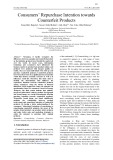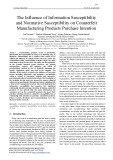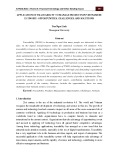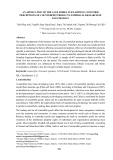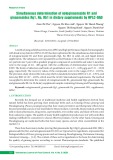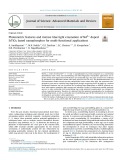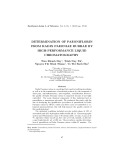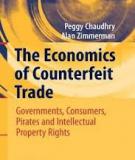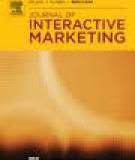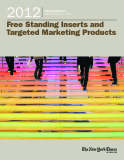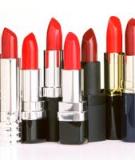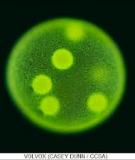
Counterfeit products
-
Domestic consumption of nutritional products and food supplements are on the rise. This is due to the fact that consumers have become more affluent and aware of their health. Edible bird’s nest (EBN) is used as a health supplement for medicinal benefits to improve health quality. However, issues such as contamination and counterfeit EBN have caused fluctuation of the product’s price over time and consumers are slowly shunning away from consuming EBN products.
 6p
6p  longtimenosee10
longtimenosee10
 26-04-2024
26-04-2024
 1
1
 1
1
 Download
Download
-
This study aims to identify the determinants that influence the repurchase intention towards counterfeit products among consumers’ using the Theory of Planned Behaviour (TPB) framework. Data was collected via questionnaire from 114 consumers’ based in Penang, Malaysia. The final results indicate that attitude, perceived behavioural control, product involvement and brand image are crucial determinants affecting purchase intention towards counterfeit products.
 9p
9p  longtimenosee10
longtimenosee10
 26-04-2024
26-04-2024
 2
2
 1
1
 Download
Download
-
The objective of this study is to observe the influence of two social factors including informative and normative susceptibility which is related to consumers’ attitude and consumers’ purchasing intention of counterfeit products.
 6p
6p  longtimenosee07
longtimenosee07
 29-03-2024
29-03-2024
 4
4
 2
2
 Download
Download
-
Traceability (TXNG) is becoming a trend that many people are interested in these days. In the digital transformation within the industrial revolution 4.0 (Industry 4.0), traceability is known as the solution to solve the counterfeit, imitation goods, and low-quality goods consumed in the market.
 17p
17p  viindra
viindra
 06-09-2023
06-09-2023
 6
6
 3
3
 Download
Download
-
The rapid development of the business and the use of counterfeit products negatively affect many companies, industries, even the economy and consumers. Therefore, this study was conducted with the aim of evaluating the factors affecting consumers' perception of the use of counterfeit products, specific to electronics. The study examines the relationship of psychological stimuli with utilitarian and hedonic attitude and consumer intentions to use counterfeit electronics based on modified Stimulus-Organism-Response (S-O-R) model.
 17p
17p  nhanchienthien
nhanchienthien
 25-07-2023
25-07-2023
 7
7
 6
6
 Download
Download
-
The quality of many health supplement products are not well controlled, making it difficult for consumers to choose effective products. On the other hand, Ginseng and Pseudoginseng are medicinal herbs that have many species and are often counterfeited in the market.
 11p
11p  chauchaungayxua12
chauchaungayxua12
 11-07-2021
11-07-2021
 9
9
 1
1
 Download
Download
-
The optimized nanophosphors were used to visualize latent fingerprints through recognizing level I-III ridges by a reduced background hindrance and can be utilized for visualizing latent fingerprints on difficult substrate surfaces with superior sensitivity, high contrast and selectivity. Further, a furthermost possible stochastic process to make unclonable anti-counterfeiting tags using optimized nanophosphor was designed to reduce counterfeit products.
 10p
10p  larachdumlanat129
larachdumlanat129
 14-01-2021
14-01-2021
 10
10
 2
2
 Download
Download
-
Radix Paeoniae rubrae is a medicinal herb used in traditional medicine as well as in the manufacture of medicinal products for the treatment of chest pain, anti-inflammatory, anti-coagulant, vasodilatation However, the quality of Radix Paeoniae rubrae is suspected because of not tight controlled. The main chemical component of this medicinal herb is paeoniflorin, a monoterpen glycoside.
 9p
9p  trinhthamhodang9
trinhthamhodang9
 10-12-2020
10-12-2020
 9
9
 1
1
 Download
Download
-
Product counterfeiting is a well-known problem, one that has been with us for a very long time. Trademarks go back to ancient times and where there are trade- marks counterfeiting soon follows. Recently more attention is being paid to fighting the problem. It would seem the first logical step would be to determine the size of the counterfeit market. But this is more difficult than it appears to be. First, no direct measurement of counterfeit trade can be undertaken, since by definition this is an illegal activity.
 201p
201p  lyly_5
lyly_5
 23-03-2013
23-03-2013
 46
46
 5
5
 Download
Download
-
In mid-2004, executives at the Tokyo headquarters of the huge electron- ics multinational NEC began to hear reports that its products were being counterfeited and sold in Chinese stores. Nobody was at all surprised. Reports of this kind were routine for any corporation of NEC’s size and reach, and in this case they initially seemed to concern small stuΩ—blank DVDs and the like. The company nevertheless moved swiftly to put into action its standard response in such cases, hiring a firm called Inter- national Risk to look into the matter.
 636p
636p  lyly_5
lyly_5
 23-03-2013
23-03-2013
 45
45
 4
4
 Download
Download
-
While total online marketing spend continues to grow, the returns on that investment are increasingly under attack by pay per click scams perpetrated by those who exploit powerful brands for their own profit. Scammers, misguided affiliates and unscrupulous competitors place a company’s branded terms within search ad copy, or use the terms as keywords to divert search users to sites which offer competing products or even to illegitimate sites offering counterfeit, pirated or grey market goods.
 9p
9p  nhacchovina
nhacchovina
 22-03-2013
22-03-2013
 59
59
 9
9
 Download
Download
-
The use of the internet as a method of purchasing counterfeit goods was most common for films, with 12 per cent of purchasers using this electronic shop front. However, respondents were more than twice as likely to purchase films from social environments (26 per cent) or on holiday (29 per cent). We do not wish to under- estimate the importance of the internet for the sale and distribution of counterfeit products, as this distribution channel is most likely to show greatest growth in the future. However, it is notable that less than a third as many people reported acquiring...
 25p
25p  nhacchovina
nhacchovina
 22-03-2013
22-03-2013
 69
69
 4
4
 Download
Download
-
If the consumption of counterfeit goods is consistent with other forms of routine consumption practices, it is likely that they are purchased in everyday environments and situated within routine social contexts. Such a view is supported by the questionnaire data. Rather than being integrated into a subcultural technical elite, the most regular sites of purchase of counterfeit products were more mundane.
 13p
13p  nhacchovina
nhacchovina
 22-03-2013
22-03-2013
 76
76
 5
5
 Download
Download
-
When asked about purchase of counterfeit goods over the last twelve months, the most commonly purchased were music (16.2 per cent of the entire sample), films (16.0 per cent of the entire sample), and fashion items (15.5 per cent of the entire sample). This is consistent with the products identified as providing the most lucrative markets for counterfeiters as outlined in the introduction. For the entire sample, downloading of pirated files was less common with 14 per cent having downloaded illegal music tracks, 6 per cent whole albums and 5 per cent films or TV programmes. ...
 12p
12p  nhacchovina
nhacchovina
 22-03-2013
22-03-2013
 68
68
 5
5
 Download
Download
-
This paper draws upon data from a research project undertaken in Great Britain and Northern Ireland. vii The focus on consumers/end users to develop a broad and situated view of the consumption of counterfeit goods led the data collection to focus primarily on counterfeit versions of leisure goods (e.g., fashion clothes, music, film, games, and other software). The distinction between leisure goods and other types of counterfeit items is not merely one of convenience.
 17p
17p  nhacchovina
nhacchovina
 22-03-2013
22-03-2013
 69
69
 6
6
 Download
Download
-
The research detailed in this paper is used to question the utility of investigating the consumption of counterfeiting not through the lens of subcultures, ethics or legality, but as a more routine and situated practice. As such it draws upon broad survey data of consumers and non-consumers of counterfeit and pirated goods. It also details a range of consumer and leisure items to address the limitations of previous empirical research based upon smaller or more homogenous consumer samples (e.g., Albers- Miller, 1999) or products (e.g., Ang et al., 2001).
 10p
10p  nhacchovina
nhacchovina
 22-03-2013
22-03-2013
 73
73
 4
4
 Download
Download
-
This emphasis on the spectacular and exotic, consistent with an oppositional or marginal view of the consumer, is often also emphasised in academic writing on counterfeiting. Consumers of counterfeits are often represented through anecdotal narratives which serve as a proxy for deeper understanding of consumer motivations. For example, Lasica (2005) illustrates his work with case studies which potentially confuse everyday users with vanguard consumers.
 10p
10p  nhacchovina
nhacchovina
 22-03-2013
22-03-2013
 66
66
 4
4
 Download
Download
-
In popular discourse, academic research and trade association awareness campaigns, the consumer of counterfeit goods is frequently constructed as ‘other’. vi In industry and policy they are represented as outside accepted everyday experience either as part of a criminal or technological underworld, terrorist organisation, or as socially isolated, morally corrupt or part of a subversive subculture.
 17p
17p  nhacchovina
nhacchovina
 22-03-2013
22-03-2013
 64
64
 5
5
 Download
Download
-
Developments in, and availability of, new production technologies which have reduced the cost and time necessary to make illegal copies of goods have played a part in this growth. This has contributed to growth in markets for counterfeit goods as the amount and range of products create increased profits for those involved in this activity (Savona and Mignone, 2004).
 8p
8p  nhacchovina
nhacchovina
 22-03-2013
22-03-2013
 46
46
 4
4
 Download
Download
-
The illicit and covert nature of counterfeiting makes evaluating the exact value of these markets problematic and to be regarded with some caution (OECD, 1998; Dixon and Greenhalgh, 2002). However, estimates of the economic cost of counterfeiting to industry and government offer some indication of the size of the markets. Quoting European Commission figures, the OECD estimated in 1998 that counterfeit goods were worth between 5-7 per cent of world trade, and had demonstrated 150 per cent growth in value between 1990 and 1995 (OECD, 1998, p.23).
 11p
11p  nhacchovina
nhacchovina
 22-03-2013
22-03-2013
 47
47
 4
4
 Download
Download
CHỦ ĐỀ BẠN MUỐN TÌM









